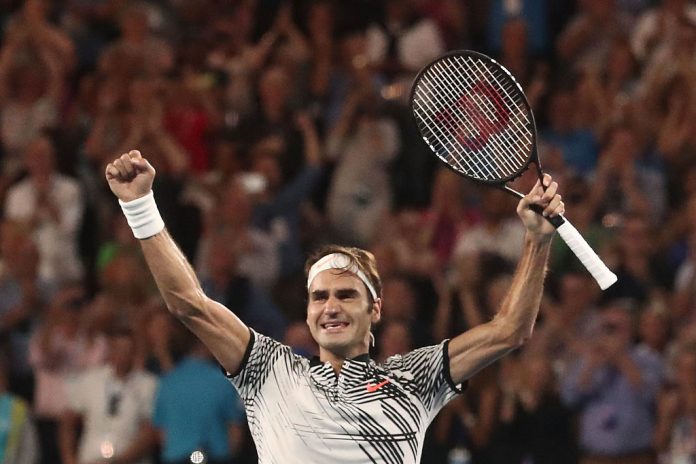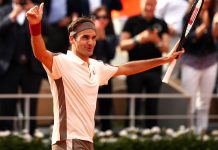Melbourne –
Bill Simons
The rivalry captures so much. It evokes so much: the dreamy, immaculate dancer Fred Astaire floating and free vs. the bounding, energetic hoofer Gene Kelly. Poet pugilist Muhammad Ali vs. the pounding powerhouse Joe Frazier. Take your choice: elegant artist or lunch-bucket warrior.
“Roger vs. Rafa” gives us a sweet sounding alliteration as well as a mind-boggling anomaly. Federer – with 17 Slams to Rafa’s 14 – long ago was anointed as the Greatest Of All Time. But Nadal has dominated him. He has crushed Roger on clay courts, has an 8-2 record on outdoor hard courts and a 10-2 record at Slams, leading 23-11 overall.
Tennis is crowded with great rivalries. The short-tempered rebel Mac vs. the long-haired idol Borg set the table for the modern game. The hatred between McEnroe and Connors screeched loud. Agassi vs. Sampras gave us years of delight. The Bryan brothers recently recalled how tennis fell into two distinct camps – you were either a Pete person or an Andre person. (The Bryans papered their childhood bedroom with Agassi posters.) In the bigger picture, though, there was a problem. As fabulous a player as Sampras was, his low key “I’m just a tennis player – nothing more, nothing less” personality meant the rivalry couldn’t soar beyond the limits of sports.
Andy Murray and Novak Djokovic are now No. 1 and No. 2, and recently have played far more matches than Roger and Rafa. But their styles give us such a sameness – mirror images that don’t ignite the imagination.
Rafa and Roger give us great charisma, great tennis and great differences. The adored metro-chill and near-perfect Roger is so suave – though perhaps a tad imperious. Federer’s a father of four, an artsy corporate spokesperson, a stylish fashion maven and a flawless tennis ambassador – with a foundation in Africa, no less. Rafa – a humble, deeply dimpled hunk who was reared on a Mediterranean island – has an autobiography, his own tennis academy, his own museum and a foundation in India. And he delights in doing Tommy Hilfigger underwear commercials. Earthy and gritty, he imposes his will and crushes foes. All Roger does is defy gravity. He is the man who cannot avoid beauty.
The duo are as different as the Spanish sea and an Alpine peak. Goodness, here at the Aussie Open, they couldn’t even agree on fishing. With a deft flick, Federer dismissed the sport – not interested – while Rafa described the glories of venturing out on the sea – man, boat and waves.
Of course, if you’re fishing for significant moments of the Rafa-Roger rivalry, it’s a breeze. Let’s not even ponder whether Rafa’s high bouncing, topspin lefty forehand, which so often punishes Roger’s elegant one-handed backhand, is the most important stroke mis-match in tennis history. And let’s only chuckle briefly when we recall how Roger and Rafa, after flubbing their lines for a charity TV commercial, broke into uncontrollable howls of laughter like two seventh graders having a ball.
Rather we recall when Roger got a rare advantage over Rafa at the 2006 French Open, winning the first set 6-1, before Nadal summoned his clay court superiority. After losing the fierce 2009 Australian Open final, Federer broke down, proclaiming, “This is killing me.” Nadal then famously consoled his weeping foe. But their was little consolation for Roger when he lost to Rafa in the best match in tennis history, his storied 2008 “Battle in the Dusk” at Wimbledon.
That was then – this is now. Today’s headline screamed, “Tennis Heaven.” “Think about the historical significance [of the final],” said Andy Roddick. “One player [Nadal] at 14 slams, one player [Federer] at 17 slams. Rafa wins, it’s 15-17, and the French Open is around the corner – [and their fabled rivalry] is back on. It’s literally game on for the most Slams ever. If Roger wins, it’s 18-14 and that will be hard for Rafa to catch…It has to be the most important match in Australian Open history and possibly Grand Slam history.”
No wonder the papers shouted “Tennis Heaven.” Rui Duarte tweeted, “A Federer-Nadal GS Final is like the Tennis Gods calling and saying, ‘We’re still here.'”
Brad Gilbert said the final is “the biggest match in the Open Era with the most implications.” And when Roger scored two backhand winners to break in the first set, the implications were clear. It didn’t matter what the head-to-head record said – that he’d never beaten Rafa in Australia and that he’d already played two grueling five-set matches – It was game on.
Yes, two nights ago Nadal downed “Baby Fed” – Grigor Dimitrov. But the real Fed is a whole different matter, and Roger claimed the first set 6-4 in 34 tidy minutes.
Then a Federer double fault and a fine looping Nadal forehand allowed Rafa to break early in the second set and grab the momentum, as he won the set 6-3.
In the opening game of the third set Nadal continued his surge, gaining three break points. But Federer stepped up, unleashed his underrated, hard-to-read serve and blasted three critical aces to blunt the Spaniard. Roger that! The tour de force changed everything.
Suddenly, Roger got belief, and fans soon were relishing the most beautiful sight in tennis: Fed in the zone.
Sprinting winners, half-volley forehands to the open court, fabulous flicks and service returns that embraced the lines, Roger even had a spectacular Hawkeye challenge and a lucky let chord. This is the dreamy package we’ve adored since he first beat Pete Sampras in 2001. Rafa may have had him on his heels, running him corner to corner – but no problem. Roger sprints, Roger extends, Roger blasts. The genius was surging. Here was Federerian brilliance – with all its gravity-defying, free-form beauty -– at its best. The man fuses balance, power and balletic grace to write athletic poetry – in this case, a 6-1 third set sonnet. But even poets sometimes misfire, and you knew the fiercest fighter in the game since Jimmy Connors would counterattack ferociously.
As Roger began to shank forehands and net volleys, the swarming seagulls above the stadium circled and squawked as if to say, “This cannot be.” Nadal tightened his defense and improved his serve, adeptly capturing the fourth set 6-3. It only made sense that the biggest match in memory would go five sets. Nadal, the winds of fate seemingly at his back, took advantage of three Federer forehand errors to break, and sprint to a 3-1 lead.
Matters looked bleak for Roger. Rafa was holding serve with some ease. Federer confided later to ESPN that he’d then begun to hit the ball more cleanly. He’d understood that he needed to get up on the court, to counter Rafa’s body serve, to be offensive and take Nadal’s speed away. All he’d needed, he said, was “a couple of connections.” Finally, in the sixth game, Roger’s backhand caught fire, and on the second break point of the game, a classic Nadal inside-out forehand flew just wide.
Roger broke to even the decisive set 3-3. Then in Nadal’s next service game, on his fifth break point, no less, Roger hit a sharply angled return of serve to gain yet another break and go up 5-3. Astounding.
This was sports theater at its highest level. Old man Federer, 35, on the brink, stepped up his game just when all seemed lost. On his second championship point he hit a forehand that was called in. The title was his – no, wait! Hit the pause button! Rafa challenged. But looking up at his team, Roger saw their pure elation. And he knew, after an almost five year drought, that he’d won his 18th Slam. In a celebratory Slam, packed with nonstop feel-good stories – Venus, Serena, Rafa, Zverev, Luic-Baroni -– Federer made the tennis world tingle. Yes, at least for now, he is the Greatest of All Time. He would say that his long awaited win had a magnitude he could only compare to finally winning the French Open in 2009.
Soon this great man, rock star and champion was circling the arena, holding the trophy high, blowing kisses. Six months after blowing out his knee while running a bath for his kids, he had finally blown away his greatest rival – while blowing our minds.
But then again, the Almighty Fed has been doing that for 15 poetic, triumphant years.
Additional reporting by Tanya Liesegang



















